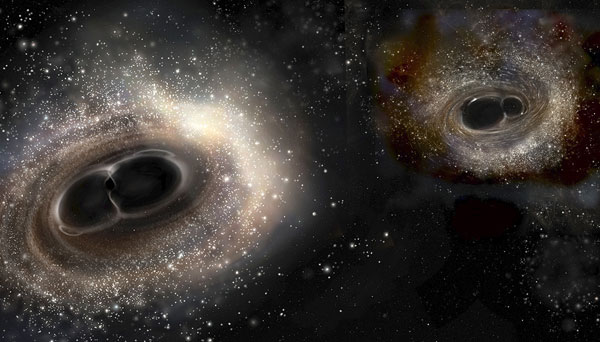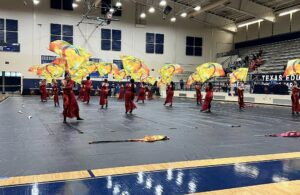- La Feria Community Holds Succesful Business Mixer Event
- Little Nashville to Take Place in Downtown Mercedes
- Lions Basketball Captures District Gold
- La Feria ISD Students Compete in Regional Chess Tournament
- Lions End First Half of 32-4A on a High Note
- La Feria ISD Held Another Successful Parent Conference
- Strong Appearance for Lions at Hidalgo Power Meet
- LFECHS Students Get to Meet Local Actress
- Students Participate in Marine Biology Camp
- Two LFECHS Students Qualify for All-State Band
Gravitational Waves Detected – Again!
- Updated: June 24, 2016
The LIGO Scientific Collaboration and the Virgo Collaboration have identified a second pair of colliding black holes, in data from the Advanced LIGO detectors
RIO GRANDE VALLEY, TEXAS – On Dec. 26, 2015, at 03:38:53 UTC, scientists observed gravitational waves – ripples in the fabric of spacetime – for the second time.
The gravitational waves were detected by both of the twin Laser Interferometer Gravitational-wave Observatory (LIGO) detectors, located in Livingston, Louisiana, and Hanford, Washington.
The LIGO Observatories are funded by the National Science Foundation (NSF), and were conceived, built, and are operated by Caltech and MIT. The discovery, accepted for publication in the journal Physical Review Letters, was made by the LIGO Scientific Collaboration (which includes the GEO Collaboration and the Australian Consortium for Interferometric Gravitational Astronomy) and the Virgo Collaboration using data from the two LIGO detectors.
Scientists with The University of Texas Rio Grande Valley, which houses the Center for Gravitational Wave Astronomy, were part of the international team of scientists who contributed to both the initial and now the second detection of gravitational waves. CGWA has the largest group of gravitational-wave researchers in Texas and is one of the largest from the United States involved in the LIGO Scientific Collaboration (LSC) global research effort.
“Discovery of a second gravitational wave event only strengthens the scientific significance, and reconfirms and reassures the tremendous effort of more than a thousand scientists around the world,” said Dr. Soma Mukherjee, UTRGV physics professor and chair of the Department of Physics. “I am very glad that several professors and graduate students from UTRGV have been a part of the LIGO Scientific Collaboration and have contributed significantly to multiple aspects of the global team effort.”
Mario Diaz, director of the UTRGV Center for Gravitational Wave Astronomy, said the next challenge will be to detect the merger of compact objects that include at least one neutron star.
“The fusion of a black hole and a neutron star or two neutron stars is expected to have an electromagnetic counterpart, and its observation by astronomical observatories operating optical and other electromagnetic instruments could make a major contribution to a better understanding of such processes,” he said.
“In that sense, it is particularly promising that the Ministry of Science and Technology in Argentina has approved funding for an American-Argentine project designed to deploy an optical wide-field telescope dedicated to follow-up observations of these events in the Macon mountains, located within the highlands of the Atacama desert in Northern Argentina, one of the regions with the clearest skies in our planet,” Diaz said.
Diaz is a member of the LIGO Scientific Collaboration, and principal investigator of the TOROS project. The TOROS (Transient Optical Robotic Observatory of the South) collaboration is a joint effort of Argentine, Mexican, Chilean, Italian and American astronomers dedicated to the search of optical and electromagnetic counterparts of gravitational wave events.
Gravitational waves carry information about their origins and about the nature of gravity that cannot otherwise be obtained, and physicists have concluded that the detected gravitational waves once again were produced during the final moments of the merger of two black holes – 14.2 and 7.5 times the mass of the sun – to produce a single, more massive spinning black hole that is 20.8 times the mass of the sun.
Gabriela Gonzalez, international LIGO spokesperson and professor of physics and astronomy at Louisiana State University, said it is very significant that these black holes were much less massive than those in the first detection.
“Because of their lighter mass, they spent more time – about one second – in the sensitive band of the detectors,” she said. “It is a promising start to mapping the populations of black holes in our universe.”
During the merger, which occurred approximately 1.4 billion years ago, roughly the equivalent of the mass of the sun was converted into gravitational waves. The detected signal comes from the last 55 orbits before the merger. The arrival time of the signals – with the Livingston detector measuring the waves 1.1 milliseconds before the Hanford detector – gives a rough idea of the position of the source in the sky.
“In the near future Virgo, the European interferometer, will join the network of gravitational wave detectors and will improve our contribution to the multi messenger astronomy, said Fulvio Ricci, the Virgo Collaboration spokesperson. “The three interferometers together will permit a far better location in the sky of the signals.”
The first detection of gravitational waves, announced Feb. 11, 2016, was a milestone in physics, confirming a major prediction of Albert Einstein’s 1915 general theory of relativity and marking the beginning of the new field of gravitational-wave astronomy.
The second discovery “has truly put the ‘O’ for Observatory in LIGO,” said Caltech’s Albert Lazzarini, deputy director of the LIGO Laboratory.
“With detections of two strong events in the four months of our first observing run, we can begin to make predictions about how often we might be hearing gravitational waves in the future,” Lazzarini said. “LIGO is bringing us a new way to observe some of the darkest yet most energetic events in our universe.”
David Shoemaker, MIT’s leader of Advanced LIGO, said the technological advances that led to these discoveries are game-changing.
“We are starting to get a glimpse of the kind of new astrophysical information that can only come from gravitational wave detectors,” he said.
Both discoveries were made possible by the enhanced capabilities of Advanced LIGO, a major upgrade that increases the sensitivity of the instruments compared to the first generation LIGO detectors, enabling a large increase in the volume of the universe probed.
“With the advent of Advanced LIGO, we anticipated researchers would eventually succeed at detecting unexpected phenomena, but these two detections thus far have surpassed our expectations,” said NSF Director France A. Córdova.
“NSF’s 40-year investment in this foundational research is already yielding new information about the nature of the dark universe.”
COLLABORATION
Advanced LIGO’s next data-taking run will be in fall 2016. By then, further detector tuning is expected to allow LIGO to reach 1.5 to 2 times more of the volume of the universe. The Virgo detector is expected to join in the latter half of the upcoming observing run.
LIGO research is carried out by the LIGO Scientific Collaboration (LSC), a group of more than 1,000 scientists from universities around the United States and in 14 other countries. More than 90 universities and research institutes in the LSC develop detector technology and analyze data; approximately 250 students are strong contributing members of the collaboration. The LSC detector network includes the LIGO interferometers and the GEO600 detector.
Virgo research is carried out by the Virgo Collaboration, consisting of more than 250 physicists and engineers belonging to 19 different European research groups: six from Centre National de la Recherche Scientifique (CNRS) in France; eight from the Istituto Nazionale di Fisica Nucleare (INFN) in Italy; two in The Netherlands with Nikhef; the Wigner RCP in Hungary; the POLGRAW group in Poland and the European Gravitational Observatory (EGO), the laboratory hosting the Virgo detector near Pisa, Italy.
Several of the key technologies that made Advanced LIGO so much more sensitive have been developed and tested by the German UK GEO collaboration. Significant computer resources have been contributed by the AEI Hannover Atlas Cluster, the LIGO Laboratory, Syracuse University, and the University of Wisconsin-Milwaukee. Several universities designed, built and tested key components for Advanced LIGO: The Australian National University, the University of Adelaide, the University of Florida, Stanford University, Columbia University of New York, and Louisiana State University. The GEO team includes scientists at the Max Planck Institute for Gravitational Physics (Albert Einstein Institute, AEI), Leibniz Universität Hannover, along with partners at the University of Glasgow, Cardiff University, the University of Birmingham, other universities in the United Kingdom and Germany, and the University of the Balearic Islands in Spain.
The NSF leads in financial support for Advanced LIGO. Funding organizations in Germany (Max Planck Society), the U.K. (Science and Technology Facilities Council, STFC) and Australia (Australian Research Council) have made significant commitments to the project.



